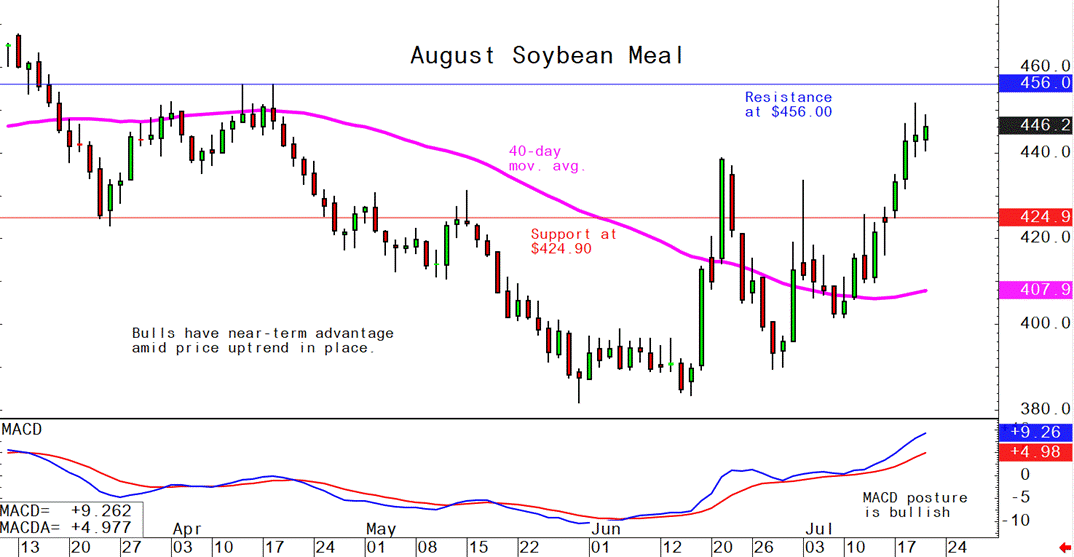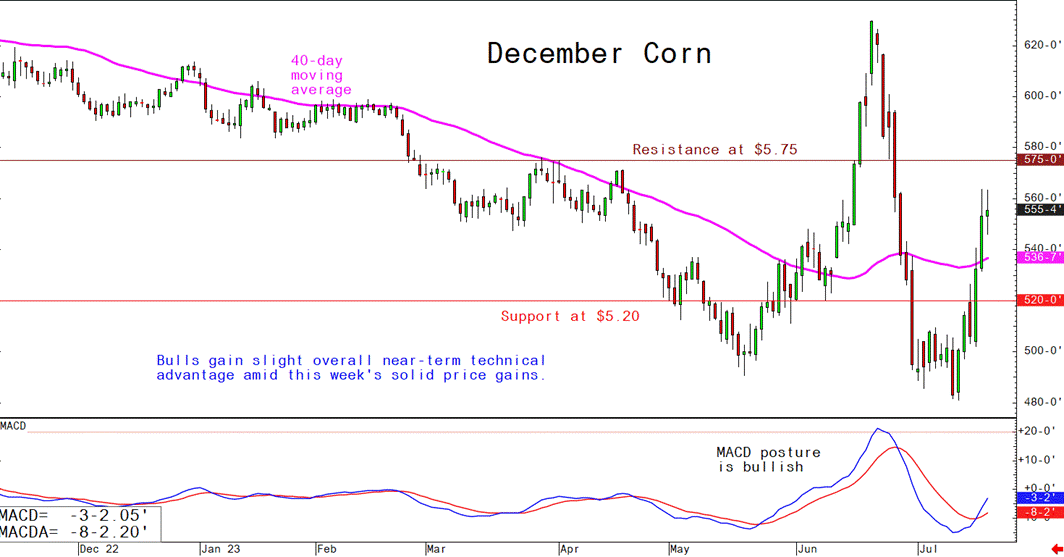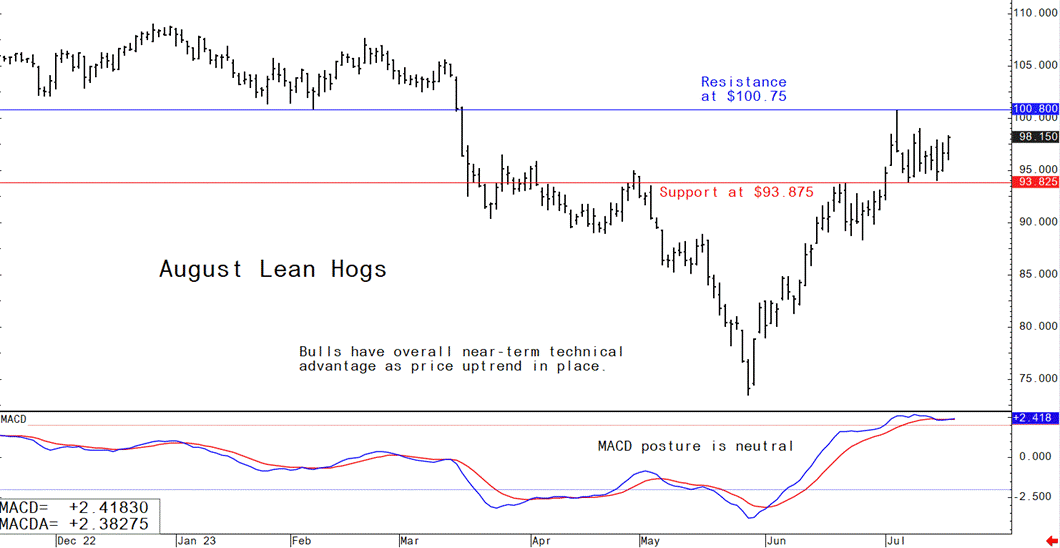



Pig outlook: Lean hog futures bulls still in control, China pork imports
Livestock analyst Jim Wyckoff shares global news for the pork industryLean hog futures bulls are still in near-term technical control and enjoying a price uptrend in place on the daily bar chart for August futures. The latest CME lean hog index is up another 78 cents to $103.30 (as of July 18). The August lean hog futures contract is still more than $5.00 below the cash hog index, which is bullish for futures. The underlying fundamentals of the hog market remain strong amid good consumer demand. Beef steak prices are at record highs, while bacon prices in June fell 16% year-over-year. Bacon demand is likely to continue to rise during BLT season.
Weekly USDA US pork export sales
Pork: Net US sales of 19,200 MT for 2023 were down 22 percent from the previous week and 28 percent from the prior 4-week average. Increases were primarily for China (5,300 MT, including decreases of 100 MT), Mexico (5,000 MT, including decreases of 400 MT), Japan (4,100 MT, including decreases of 200 MT), South Korea (900 MT, including decreases of 200 MT), and Canada (900 MT, including decreases of 400 MT). Exports of 25,300 MT were up 31 percent from the previous week, but down 12 percent from the prior 4-week average. The destinations were primarily to Mexico (8,000 MT), China (4,400 MT), Japan (4,300 MT), Canada (1,900 MT), and Colombia (1,700 MT).
China pork imports slowed a little in June but still well ahead of year-ago
China imported 130,000 MT of pork in June. While that was down 7.1% from May, it was up 4.5% from June 2022. Through the first half of 2023, China imported 940,000 MT of pork, up 16.5% from the same period last year.
Lawsuit attacks CAFO permits
The Wisconsin Dairy Alliance has spearheaded a lawsuit arguing that the state has overstepped the boundaries set by the U.S. Clean Water Act. The contention lies in the state's requirement for larger dairy farms to acquire special permits, the objective of which is to prevent manure pollution in waterways. The Dairy Alliance maintains that the stipulations extend beyond the mandates of the federal act.
Monthly USDA livestock outlook
Pork/Hogs: The Quarterly Hogs and Pigs reported June 1 numbers in breeding and market hog inventories to be about the same as a year ago. Producer farrowing intentions for the summer and fall 2023 quarters were both reported down about 4 percent and are each likely to have a negative effect on pork production in first-half 2024. Pork production is forecast at 27.4 billion pounds this year, up 1.4 percent from 2022. Production is expected to fall fractionally in 2024. U.S. pork exports are raised 110 million pounds in 2023 to 6.91 billion pounds, and in 2024 by 160 million pounds to 6.98 billion pounds based on competitive U.S. pork prices and diminished competition from other international pork exporters.
Pork/Hogs
Lower Producer Farrowing Intentions Reported in the June Quarterly Hogs and Pigs May Signal a Course Correction for the U.S. Pork Sector The Quarterly Hogs and Pigs report issued by USDA on June 29 fulfilled one of its primary functions in giving a clear response to the query of the number and classification of animals on the ground on June 1, 2023. The responses published in the report boil down to, “about the same as a year ago”—total market hog numbers (100 percent of a year ago)—thus signaling the numbers of hogs likely to be processed between June 1 and early October. The report also delivered unexpected—but exceptional—news with respect to the March–May litter rate: at 11.36 pigs per litter. This was above most analysts’ expectations but consistent with spring reports from the Swine Health Information Center. The reports showed a moderating of cases testing positive for most virulent swine diseases, especially of the various strains of porcine reproductive and respiratory syndrome, a disease that has wreaked untold havoc—in swine deaths and financial losses—along the pork production chain for the past few years.
At the time USDA issued the June report—with live equivalent prices of 51-52 percent lean hogs averaging about $63 per hundredweight—many pork producers had been operating in the red since late last year,4 largely due to high feed costs and unexpectedly weak consumer demand. In the past, such prolonged market conditions would likely have brought about a measurable reduction of the inventory of breeding animals. However, the June report indicated that the breeding inventory stood at 6.1 million head, roughly unchanged from the last report in March. The breeding information contained in the June report is likely signaling producers’ strategy for managing hog production in an environment of high feed costs and weak consumer demand that have combined to generate—according to Iowa State Estimated Livestock Returns—a series of pork producer losses averaging more than $32 per head (live) between November 2022 when the losses began and May 2023. However, since December 2022, consecutive reports have indicated minimal breeding inventory changes.
The December 1 inventory was - 0.35 percent below a year earlier, the March 1, 2023, breeding inventory was 0.04 percent lower than a year earlier, and the June 2023 inventory, at 6.146 million head, declined by -0.36 percent or 22 thousand head compared with a year earlier. It appears that even in the face of considerable losses, hog producers have opted to maintain breeding inventories largely intact, varying its numbers only seasonally, unlike in the past when losses would bring on relatively swift and significant reductions in numbers. This approach to managing a breeding operation under a prolonged period of financial stress is likely driven by the current structure of the U.S. hog industry—particularly the capital-intensive farrowing-to-wean end of the business—that aims to minimize reductions in sow numbers even during periods of extended financial loss.
In 2023 in particular, producers appear to have adopted a strategy to limit short-term losses by marketing hogs at lighter-than-usual weights. In the medium term, producers seem to be aiming at lowering hog supplies by farrowing fewer sows. With respect to hog weights, the weekly estimated average live weight of barrows and gilts for Iowa, Southern Minnesota, and South Dakota have averaged 285.2 pounds through week 26 of this year, compared to 287.7 pounds.
Production Implications of the 2023 Pig Crops It is notable that while quarterly farrowings and farrowing intentions in 2023 are each year-over year lower, litter rates can often offset farrowing reductions. This was the case in the first and second quarter of 2023 when relatively strong litter rates—especially in the March–May quarter when the litter rate was 11.36—offset farrowing reductions. Although as producers follow through with farrowing intentions as stated in the June report, strong litter rates in the third and fourth quarters of 2023 could mitigate the size of the decline in the pig crops implied by the intentions.
The December–February 2023 pig crop (fractionally larger than that of a year earlier) will be processed mainly in the third quarter of this year. Assuming slightly higher weights as corn prices moderate, pork production for the quarter should approach almost 6.6 billion pounds, almost 1 percent above a year ago. Third-quarter hog prices—live equivalent, 51-52 percent lean—are expected to average $63 per cwt, more than 21 percent below average prices a year ago and below break-even for many U.S. hog producers. The March–May pig crop, almost 1 percent greater than the same period of 2022, should be processed mostly in the fourth quarter of this year. Estimated average dressed weights are likely to be higher than last year, given USDA’s forecasts for a larger year-over-year corn crop and moderating corn prices. The larger spring pig crop will combine with expected heavier dressed weights to yield a fourth-quarter production volume of 7.1 billion pounds, 3 percent greater than a year ago.
Greater pork supplies will likely drive hog prices year-over-year lower: Prices are expected to average $57 per cwt for the quarter, about 10 percent below a year ago. If producers follow through on their stated intentions to farrow almost 4 percent fewer sows in the June–August quarter, a modest increase in litter rates would still yield significantly fewer slaughter-ready hogs in the first quarter of 2024. Anticipated increases in average estimated dressed weights due to moderating feed costs are not likely to offset lower animal numbers.
First-quarter 2024 pork production is expected to be about 6.9 billion pounds, almost 3 percent lower than a year earlier. Average first-quarter hog prices should be about $63 per cwt, almost 15 percent higher than a year earlier. Much the same scenario is likely to play out in the second quarter of 2024 if producers follow through on their reduced farrowing intentions statednin the June report. The lower fourth-quarter 2023 pig crop deriving from 4.5 percent lower intended farrowings is likely to yield a pig crop— even with trend increases in litter rates—that is too small to be offset to by anticipated estimated average dressed weight increases from moderating feed costs. Second-quarter 2024 pork production is expected to be about 6.5 billion pounds, over 1 percent below production a year earlier.
Hog prices for the second quarter of 2024 should average $68 per cwt, just under 20 percent higher than hog prices a year earlier. Reasons for Optimism As grim as the pork business has been thus far in 2023, there are several signs that the hog and pork markets may have changed direction. First, hog slaughter numbers turned seasonally lower in June, as did pork production. Estimated federally inspected (FI) hog slaughter in June this year was about 10.375 million head, almost 1 percent below a year ago. Pork production was more than 2 percent below a year ago, with lower dressed weights. June 2022 FI dressed weights were 215 pounds per head, while weekly average weights this year were estimated at about 212 pounds. As indicated earlier, June hog prices averaged more than 20 percent below prices a year ago, but the graph of daily hog prices below suggests that buyers began to pay higher prices in June for lower quantities of hogs.
China’s Q2 pork output surges
China’s second-quarter pork output rose 4.6% from last year to 14.4 MMT, the highest in at least a decade for the period. Amid poor margins and concerns of weaker prices ahead, farmers culled hog herds, increasing pork production. China’s pork output in the first half of the year rose 3.2% from the same period last year to 30.3 MMT. China slaughtered 375.48 million hogs in the first six months of the year, up 2.6% from a year ago. China’s pig herd rose to 435.17 million head in the second quarter, up 4.23 million head from the end of the first quarter.
Massachusetts enforcement of a state law necessitating suitable living conditions for livestock delayed until Aug. 23
That’s due to an ongoing lawsuit. The law instructs farmers to grant enough space for veal calves, breeding sows, and egg-laying hens to maneuver and extend their limbs. This announcement came as parties involved, including state officials, the restaurant and pork industries, require more time to assess outstanding issues following the Supreme Court's upholding of a similar California law, Proposition 12, in May.
The extension was approved by U.S. district judge Margaret Guzman to allow for further consultations and possible settlement negotiations. The Massachusetts suit, like the one taken to the Supreme Court, challenged the constitutionality of the animal welfare standards established by a 2016 referendum, known as Question 3.
Following the Supreme Court's decision, the National Pork Producers Council stated that Massachusetts could define its own meat production standards. However, issues such as restrictions on shipping noncompliant pork products through Massachusetts to other New England states or other countries remain unsettled.
Question 3 not only establishes standards for Massachusetts farmers but also prohibits the sale of goods from other states unless they abide by Massachusetts' regulations. According to the NPPC, this creates additional obstacles in the pork supply chain by preventing the transportation of noncompliant pork through Massachusetts for delivery to other locations.
NPPC’s take: “This extended implementation allows the coalition and Massachusetts to continue discussions on implementation to ensure a smooth transition — including the transshipment and exports of pork through Massachusetts — so pork can continue to reach other New England states as well as provide guidance to the industry and supply chain. It is important to note that this Status Report and Joint Motion to Extend Stay does not change Q3, the rules, or what it means to be compliant. It simply extends the existing enforcement stay for a few more weeks.”
The next week’s likely high-low price trading ranges:
August lean hog futures--$93.875 to $100.75 and with a sideways-higher bias
August soybean meal futures--$430.00 to $460.00, and with a sideways-higher bias
December corn futures--$5.20 to $5.80 and a sideways-higher bias
Latest analytical daily charts lean hog, soybean meal and corn futures












